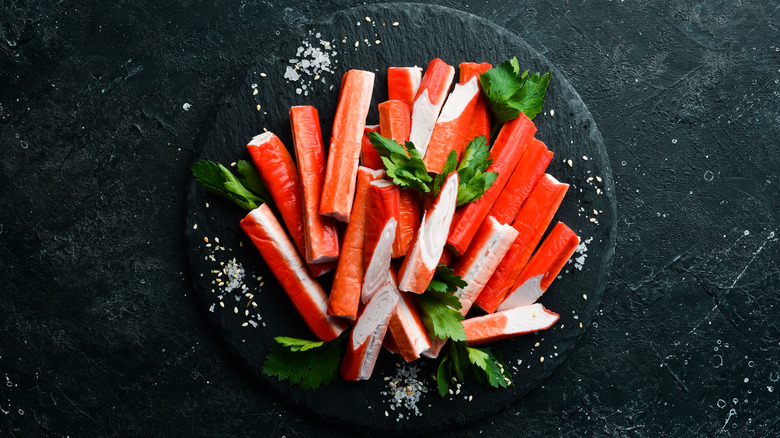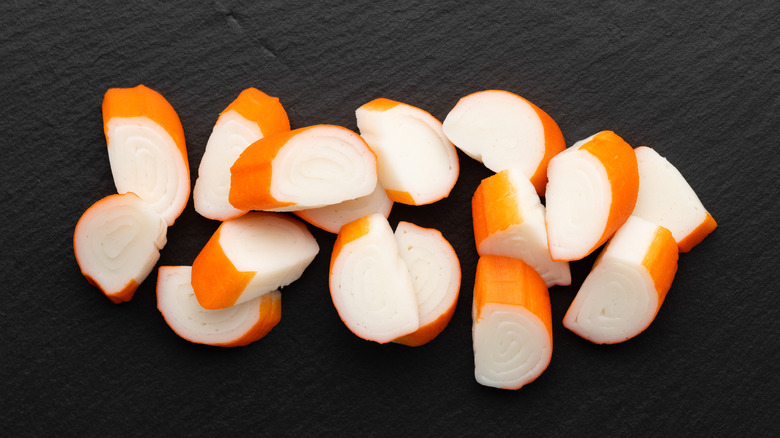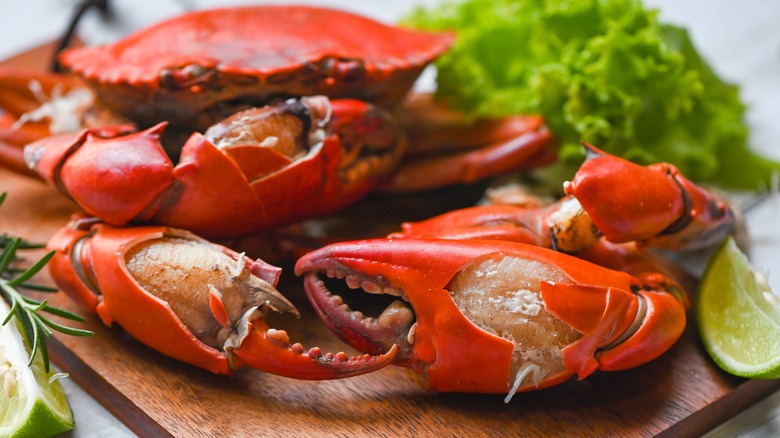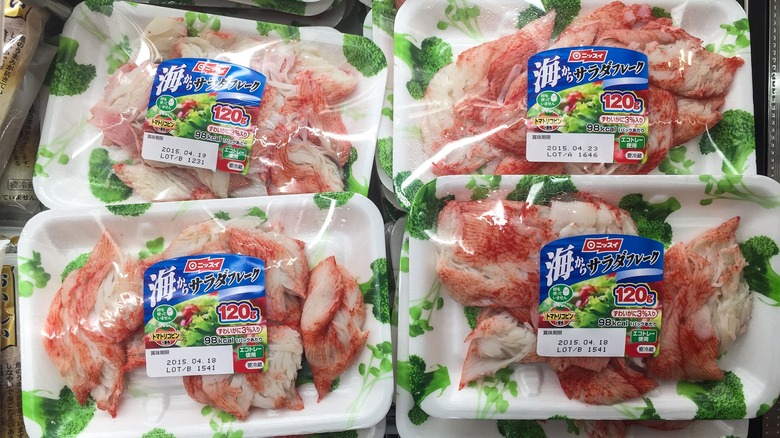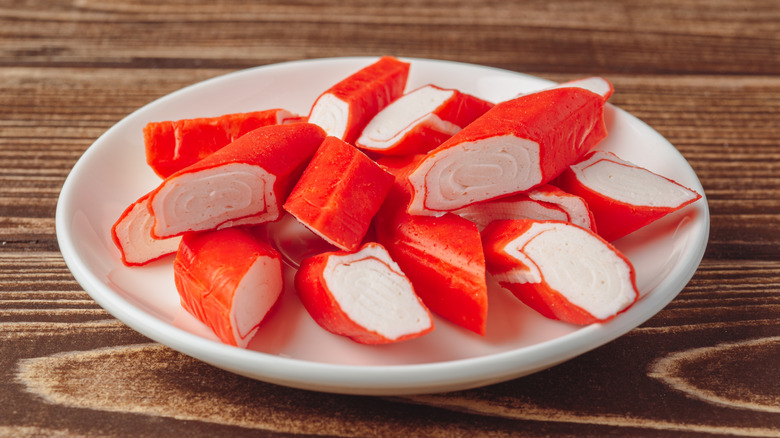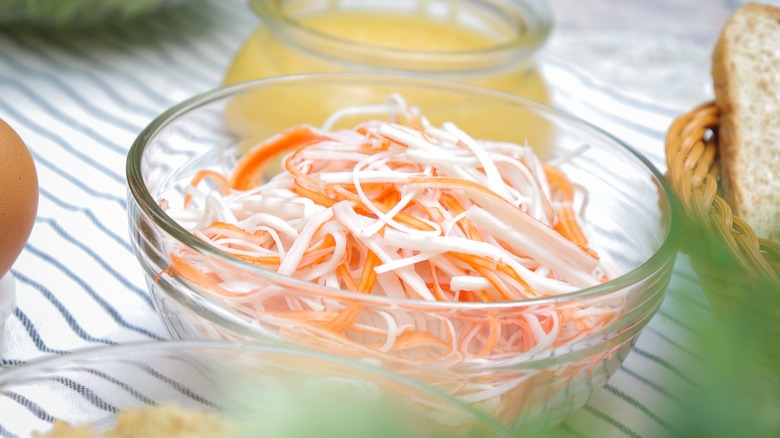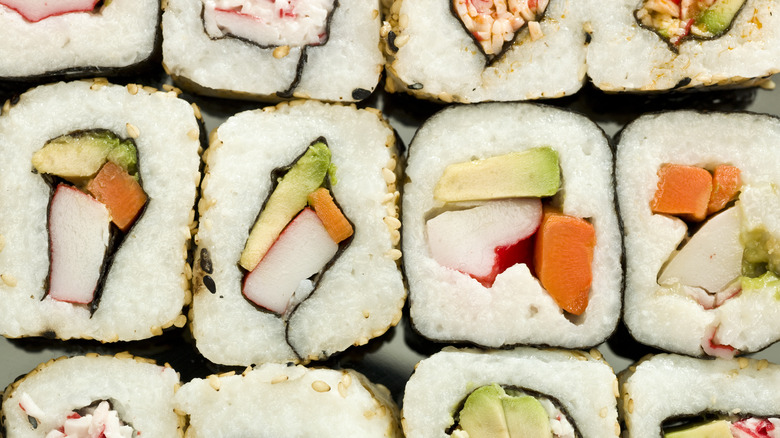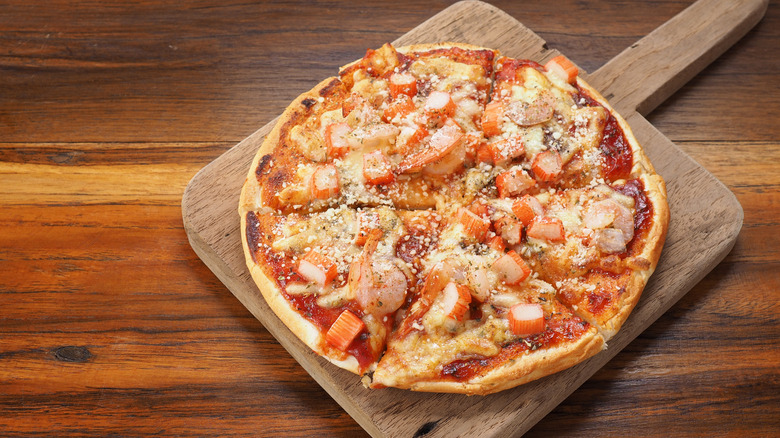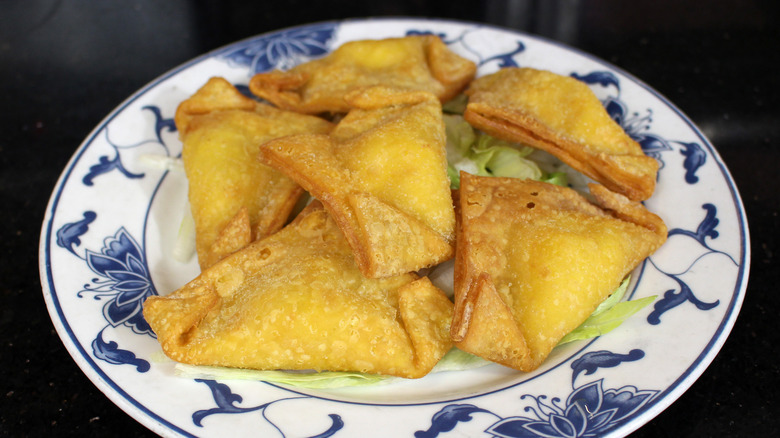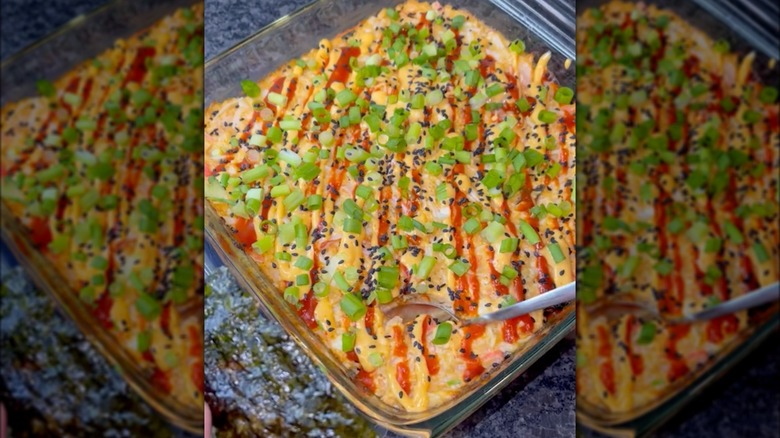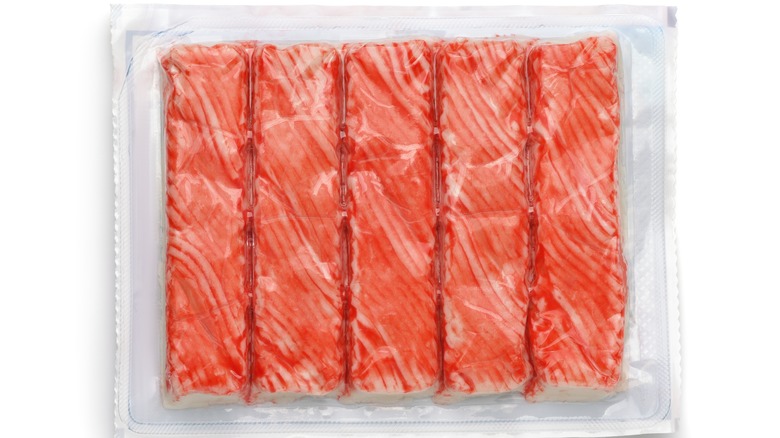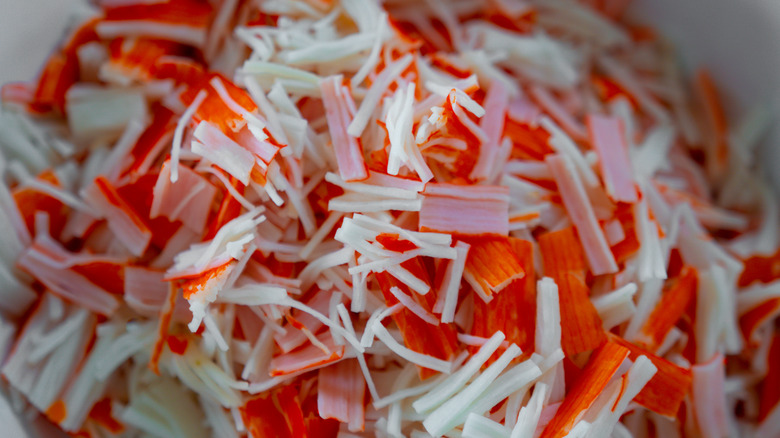Everything You Need To Know About Cooking Imitation Crab
Chances are you've heard of it, eaten it, and enjoyed it — but you still might not really know what imitation crab is or how to cook with it. Even if you've never picked up a pack and tried to implement it into a recipe at home, you've likely eaten plenty of imitation crab if you regularly visit Asian restaurants. The delicious product was first developed in Japan in the 1970s as an affordable, seafood-based alternative to crab meat. Since then, it has become a staple in restaurants and kitchens around the world, used in everything from California rolls to salads and stir-fries.
Yes, it's right there in the name: It's not actually crab meat. But what exactly is it? How do you cook with it? How do you store it? Do people with allergies have to stay away? We're covering everything you need to know about cooking imitation crab, so you can start using this convenient and delicious ingredient in your kitchen.
It doesn't actually contain crab meat
It's called imitation crab, so it shouldn't come as a shock that it doesn't contain real crab. However, it isn't made of some diabolical artificial substance. It's actually made of real fish protein called surimi, which is the minced meat of white fish. Some examples of fish used for imitation crab include tilapia, cod, haddock, whiting, or Alaskan pollock. After the fish is minced into a fine paste, it's mixed together with other flavors and thickeners. These can include salt, sugar, egg whites, and starches, as well as a tiny bit of extra crab extract for a touch of flavor. Finally, it is formed into a tubular shape; no wonder it's sometimes referred to as the hot dog of the sea.
Although it might seem like a modern invention, surimi has a long history. Ever since the 12th century, it has been used by Japanese chefs in order to reduce food waste. Once it found its way to the United States around the 1980s, it became a popular ingredient in restaurants and households around the country. Today, the global surimi industry brings in over $6 billion and is estimated to hit $11 billion by 2033.
Seeing that it's not real crab meat, the Food & Drug Administration (FDA)-approved labels must indicate either "imitation crabmeat" or "fish protein." Nevertheless, it's a delicious and cost-effective alternative to the real stuff.
It doesn't have the same nutritional value as real crab but it has plenty of benefits
It's worth noting that imitation crab doesn't have the same nutritional value as real crab meat. The biggest difference you'll find is the fake stuff consists of around two-thirds carbs and one-third protein. On the other hand, Alaskan king crab contains no carbs, and most of its calories come from protein.
Real crab meat is also much richer in micronutrients like zinc, vitamin B12, selenium, and vitamin C. Remember, imitation crab is mainly made out of pollock and cod, which doesn't contain as many of these nutrients to begin with. The other additives combined with the fish to produce the final result are not as nutritious as crab.
However, there are plenty of reasons why imitation crab is so popular. First and foremost, it tends to be significantly cheaper than genuine crab meat. It's also incredibly convenient and ready to eat out of its packaging, so you don't need to worry about removing the meat from tough shells. You can choose from several different formats of imitation crab depending on what you're making, such as chunks, sticks, or shredded meat. And in the end, you're getting a product that tastes quite similar to the real thing and works well in a number of dishes.
It's already fully cooked and ready to go
If you're wondering whether you can eat raw imitation crab, you aren't likely to come across it uncooked. One of the biggest advantages of imitation crab is that it's precooked, which means it's ready to be added to a dish. When surimi is processed behind the scenes, it is cooked (another similarity with hot dogs), making it a popular snack to eat straight out of the wrapper. If you've purchased imitation crab from the store, you've likely noticed that it's often vacuum-sealed to kill off any bacteria by depriving it of the oxygen it needs to survive.
However, although it is a highly processed food, it can definitely still expire. The shelf-life of the product varies widely depending on where you bought it, how it's been packaged, and whether it is refrigerated or frozen. Most vacuum-sealed versions have a use-by date that will last a couple of months. However, once you open the package, you should eat it within three days. Like other seafood, imitation crab will spoil rather quickly. Frozen imitation crab, on the other hand, should retain its quality anywhere from 10 to 12 months in the freezer, and should still be safe to eat even after that.
Different varieties of imitation crab have different uses
When you think of imitation crab, you probably picture the long sticks that you can pull into strings. However, there are several different varieties with a range of textures. Four common types include chunks, flakes, shreds, and sticks.
Chunk and flake-style imitation crab come in thicker lumps of meat that are great for recipes where you want fuller bites, such as crab dips, crab cakes, salads, pasta, or casseroles. They also work well in soups or even as pizza toppings. However, this type also tends to be a bit chewier, sweeter, and more rubbery than others. Opt for this style when you're looking to add meaty chunks to your recipes.
On the other hand, crab sticks are commonly found at Asian grocery stores all over the world. These are shaped to resemble the meat you pull out of a crab leg and can also be shredded. They are usually less dense than flakes or chunks but tend to be juicier and more flavorful. These are often added to sushi rolls, sandwiches, wraps, salads, and even tacos. Sticks are a great snack on their own or served with cocktail sauce for an extra kick.
Make sure to be careful around people with allergies
Although imitation crab is processed, it doesn't mean it won't trigger any allergies. Two of the most common major food allergens include crustacean shellfish (like crab) and fish (like imitation crab). Unfortunately, fish allergies can be triggered by eating anything that has fins and gills — including the surimi used to make imitation crab.
Anyone with a seafood-related allergy should be cautious and read imitation crab labels to see the ingredients. Major food allergens are always listed clearly on the packaging according to the Food Allergen Labeling and Consumer Protection Act of 2004. Trace amounts of crab are often added to fish-based imitation crab for flavoring purposes, so if you have an allergy to either crustacean shellfish or fish, it's probably best to stay away.
Also, seafood isn't the only element going into imitation crab. Other ingredients like various starches, eggs, and vegetable oil help create its shape, texture, and appearance. Additives might include MSG, xanthan gum, and preservatives like sodium benzoate, so make sure to check the label if you have any other food intolerances.
Shred your imitation crab like a pro
If you've ever had to break apart a lot of imitation crab by hand, you know it can be a difficult and time-consuming chore. It can also lead to awkward shapes that don't come apart cleanly. The conventional advice for shredding imitation crab is to use two forks and pull them apart in opposite directions, but there are a few other tricks people swear by that can cut your prep time down significantly.
One tip for shredding crab sticks is to simply press the side of your knife blade on the surface and slide it over the sticks while applying pressure to the top of the knife with your other hand. Repeat the process in the same direction over the imitation crab meat as many times as you need to get the shredded consistency you want. After that, you can cut the remaining shreds to whatever length fits your recipe.
Shredding chunk and flake-style imitation crab isn't any easier than sticks. Working a knife over the crab meat can be difficult because of its slippery and rubbery texture, making it hard to get the uniform strands you want. Thankfully, there are easier ways to get it done. One TikToker went viral for a simple hack that consists of grabbing a few chunks of imitation crab meat at a time and simply squeezing the water out. Like magic, the meat comes out perfectly shredded and ready to cook.
The best (and most common way) to use it is chilled
Since imitation crab is ready to eat right out of the package, it makes it an incredibly convenient ingredient to add to recipes — or even as a tasty snack on the go. Although it can be cooked in several ways, using it as is might be the most common way. It's often added as a filling for California rolls and other kinds of sushi. Another option is to mix it into a salad as the main protein filler. Skip shrimp and use imitation crab as a low-cost substitute in a seafood salad or cool, creamy pasta salad.
It can even be the star of the show in a simple shredded side salad with mayonnaise, sesame oil, and sriracha for a bit of heat. Or, add it to sauces, soups, dips, pasta, stir-fries, and casseroles and allow the residual heat to warm it up. Any recipe that includes real crab, shrimp, or other seafood can be replaced with this inexpensive and easy-to-use alternative.
It can be sauteed, steamed, and baked as well
Although imitation crab is ready to be eaten out of the package, you can choose to cook it as well. However, it's important not to overcook it, which will cause it to become rubbery, dry, and flavorless. No matter the method, make sure to keep an eye on it so it doesn't get too dry — you really only want to heat it through.
For example, if you want to saute surimi in a pan, try cooking it at low heat and adding a bit of water or broth to ensure it doesn't dry out — you'll be adding an extra layer of flavor to the dish at the same time. Cook it lightly until the moisture evaporates, then serve it immediately. Another great way to prepare imitation crab is to steam it for several minutes. If you opt to cook it in the microwave, set the appliance to 50% power and only heat it at short intervals (around 15 to 30 seconds) until it's warm. This will ensure you don't overcook the meat, which could ruin its flavor and texture.
Deep fry (or air fry) imitation crab for a crispy treat
Almost everything tastes better when it's deep-fried, and imitation crab is no different. If you're looking for a crispy dish, start by coating the protein just like you would to make fried chicken or pork cutlets. Separate beaten eggs into one bowl, flour in a second, and panko bread crumbs in a third. Then coat the imitation crab in flour, egg, and panko. Once the pieces are ready to go and the oil is hot enough (around 350 degrees Fahrenheit), carefully drop the crab "legs" in. They should only take about a minute to fry, so be careful to avoid overcooking them. Once they're done, serve them with your favorite sauce for a crunchy snack.
If you don't want the hassle and mess of deep frying, an air fryer is another great option for making crispy snacks with imitation crab. You can opt for a recipe as simple as drizzling olive oil and salt over the protein before air frying it to create imitation crab chips. If you want to put in a little more effort, you can make crab rangoon by combining a mixture of imitation crab, garlic, green onion, cream cheese, soy sauce, and salt. Fill up wonton wrappers, then add them to the air fryer for around 10 minutes. It's a super easy way to get an American-Chinese classic on your table for a tasty snack.
Imitation crab recipes have gone viral (for good reason)
Imitation crab isn't some well-guarded secret, but it's safe to say not everyone is fully educated about how delicious it can be when used correctly. But thanks to food creators all over the internet, imitation crab is having its moment. Take Alissa Nguyen (also known as @gaming_foodie), whose sushi bake video took the internet by storm, racking up millions of views and likes.
In the video, she creates a casserole-like concoction with cooked salmon, shredded imitation crab, cream cheese, and Japanese mayonnaise spread over seasoned white rice with shredded seaweed. After baking, she tops the hot mixture with scallions, spicy mayo, sriracha, and sesame seeds to create a stunning sushi bake big enough to feed the family.
In a different video that also racked up millions of views, @chefalmafernanda put together a nourishing salad filled with cucumber, scallions, jalapeños, celery, red onion, cilantro, and a heaping serving of shredded imitation crab. For the dressing, she combined mayonnaise, lime juice, apple cider vinegar, and the juice of canned jalapeños.
Meanwhile, @mamalicious1213 took the sandwich approach in a video that was viewed more than 2.6 million times. She shreds imitation crab with a fork and combines it with eggs and milk, then gently pan fries the mixture into a kind of crab scramble. She adds it to toasted bread with lettuce for a simple and delicious imitation crab breakfast sandwich.
You can freeze imitation crab, but make sure you do it right
It's always important to safely store fish-related products to avoid any foodborne illnesses. Freezing imitation crab is a good option to preserve it for several months. However, it is recommended that you store the product the same way you purchased it. If you bought it refrigerated, keep it refrigerated. Unopened vacuum-sealed packages should be kept in the refrigerator below 38 degrees Fahrenheit and consumed by the use-by date.
If you bought your imitation crab frozen, store it in the freezer. When you want to use it, you can simply leave it in the refrigerator overnight to defrost. If you want to thaw it faster, place it in a bowl of lukewarm water — it should take anywhere from 15 minutes to an hour. Keep in mind that if you defrost frozen imitation crab and refreeze it, it might negatively affect its texture and flavor.
Know when your imitation crab has gone bad
Like any other food in your fridge, you definitely don't want to add it to your dishes if it's gone off. It's important to know the signs of spoiled imitation crab, which luckily aren't too hard to recognize. The fresh stuff shouldn't have much of a smell, and if it does, it should be mild. When it has passed its expiration date, however, it will likely begin to smell very fishy.
Another clear indication that it has gone bad is a slimy texture — it should be smooth. Lastly, if you do happen to put it in your mouth and it tastes sour, spit it out and toss it in the garbage. Any of these signs are pretty clear indicators that your imitation crab has reached the end of its life. Ultimately, it's important to make sure you're storing the product carefully. If left out at room temperature, it only has a shelf life of around two hours. Any longer and it won't be safe to eat.
